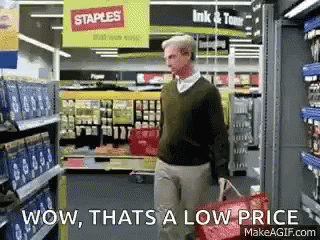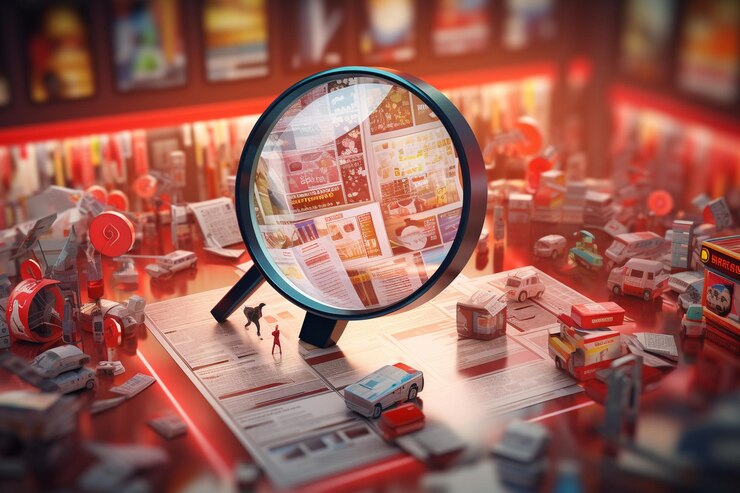How to properly get rid of illiquid goods in your business
-
Galina Ostrachinyna
Copywriter Elbuz
How to get rid of illiquid goods? This question plagues many entrepreneurs. Hundreds of hours of work, thousands of money spent, and still no result. How to deal with this problem and learn to avoid it in the future? I, Galina Ostranyna, an independent expert at the Elbuz company, am ready to share with you effective ways to solve this problem. Welcome to my world, where the secrets of online business success unfold like the pages of a magic book. In this article, you will learn the reasons for the appearance of illiquid goods, and also receive useful tips that will help you get rid of them and improve your business. Are you ready to start this exciting journey? Then read on!

Glossary
- Illiquid goods: goods that are not sold and do not bring profit to the business.
- Reasons for the occurrence of illiquid goods: failure to carry out marketing research, low demand, incorrect forecasting of demand, changing market requirements, technical problems with the product, etc.
- Identification of illiquid goods: analysis of sales, stock balances, customer reviews, application of inventory methods, comparison of inventories with actual demand, etc.
- Selling illiquid goods: holding seasonal discounts, promotions and sales, using marketing channels and resources to attract attention to the product, attracting sales specialists, using e-commerce, etc. d.
- Other ways to get rid of unsold products: partnering with other companies to recycle or resell the product, improving the quality or packaging of the product, using trade-ins or opportunities for sale in another market, etc.
- Actions if it is impossible to get rid of an illiquid product: search for additional ways to sell or use the product, maximum price reduction to stimulate potential buyers, staff training, retraining or dismissal of workers, etc.
- Preventing the appearance of illiquid stock: careful demand planning, trend analysis and forecasting changes on the market, product quality control, timely removal of outdated products from the assortment, flexibility in adapting to new requirements, etc.
- Briefly about the main thing: businesses One should actively work to prevent the occurrence of illiquid goods and develop strategies for its effective implementation. In case of failure, it is necessary to look for alternative ways to get rid of illiquid products in order to minimize losses and ensure balance in the business.
How to get rid of illiquid goods: my effective ways
What Does that mean it's an illiquid product? These are leftovers that are not sold and do not make a profit.
Over the years, I have had difficulty dealing with stock items in my business. I own a small electronics store and as new product models came out, my shelves were filled with outdated products that were left in stock. I was faced with a problem of this kind of goods that no one wanted to buy, and they began to take up space in the warehouse, interfering with the sale of more in-demand products.

Failure to sell unsold items can lead to significant financial losses, so I took on the challenge. I conducted a deep analysis of the situation and developed several effective methods that helped me get rid of illiquid goods and minimize financial losses.
Causes of illiquidity
Before discussing solutions to the problem, it is important to understand the causes of illiquidity. Out-of-market items can be the result of several factors:
Obsolete Items: In my case, some items have become obsolete due to new models and technologies. Because of this, the demand for obsolete goods decreased and they became illiquid.
Incorrect purchasing planning: Sometimes some products end up being illiquid due to poor demand forecasting. When you order too many products without taking into account customer demand, there is a risk that they will remain unsold.
Changes in market conditions: Some products may become unmarketable due to changes in market conditions, such as changes in fashion or consumer tastes. If a product no longer meets consumer requirements or preferences, its demand will decrease and it will become illiquid.
Effective ways to get rid of illiquid goods
No matter how many different reasons there are for the illiquidity of goods , there are several effective strategies that can help you resolve the problem successfully. Here are a few of them that I developed based on my experience:
1. Hold a price reduction campaign
One way to stimulate demand for illiquid goods is to hold price reduction promotions. It is necessary to set a lower price for these products to attract buyers who are interested in more affordable prices. This will allow you to quickly sell leftovers and free up space in your warehouse for new and more in-demand products.

2. Create package offers
If some products have become illiquid, but you have other products that are in demand, consider creating package deals. You can combine hard-to-find items with more popular products and sell them together at an attractive price. This will allow you to increase sales of out-of-market items and promote other products at the same time.
3. Sell through online platforms
Online platforms give you the opportunity to reach a wide audience and find buyers for hard-to-find items. You can create a profile on popular marketplaces like Amazon or eBay and sell your hard-to-find items there. This will help you reach more potential buyers and increase your chances of making a sale.
4. Contact the supplier
If you are dealing with out-of-market goods purchased from a certain supplier, try contacting them with an offer to return or replace them. Some suppliers are willing to help you resolve the issue and will offer you options for returning or exchanging items that are out of stock. This will allow you to minimize losses and use this supplier again in the future.
5. Provide special terms for partners
If you have partners or dealers, consider giving them special terms for selling hard-to-find items. Reducing the price or providing additional bonuses can encourage them to make more sales. Partners who work directly with end consumers may be more successful in selling hard-to-find products.

Summary and best practices
Getting rid of unmarketable goods is not always an easy task, but with effective strategies you can overcome this problem. I am confident that the methods proposed above will help you minimize losses and successfully get rid of illiquid goods.
| What to do | What not to do |
|---|---|
| Carry out promotions to reduce prices | Do not leave illiquid goods without attention |
| Create package offers | Don't buy more goods than you can sell |
| Sell through online platforms | Don't ignore customer feedback |
| Contact your supplier | Don't put off the problem until later |
| Provide special conditions to your partners | Don't forget to update your range |
Remember that every business is unique and not all strategies will fit all situations. Experiment and find your own solutions to solve the problem of illiquid goods. Good luck in your business!
Where do illiquid goods come from: the reasons for their appearance
As a business owner, I had experience working with illiquid goods and I was faced with a problem that needed to be solved. To understand where illiquid goods come from, I studied the reasons for their appearance. As a result of my research, I identified the main factors influencing the occurrence of illiquid assets.
One of the reasons for the appearance of illiquid goods is the incorrect calculation of demand. For example, having bought a large batch of tablet cases, I was sure that they would be popular, but it turned out that the demand was lower than expected. This led to the accumulation of goods in the warehouse and the emergence of illiquidity.

The second reason is the end of the season. It is impossible to predict which products will go out of fashion or cease to be relevant. I encountered this problem when I didn’t have time to sell off a batch of Christmas trees after the holidays ended. Outdated products also cause losses and become illiquid.
The third reason for the appearance of illiquid goods is associated with changes in fashion trends. In my work in the fashion industry, I came across a situation where dresses that were trendy in 20XX ceased to be relevant the very next year. This is due to the ever-changing tastes and preferences of consumers.
Another reason is re-grading. With uncontrolled re-grading, information about the balance of goods in the warehouse does not coincide with the actual quantity. This may occur due to accounting errors or incorrect product labeling. The batch of pots that was sold on paper actually ended up in a warehouse.
Errors in marketing can also lead to the appearance of illiquid goods. For example, an incorrect assessment of the solvency of the target audience can lead to a situation where they try to sell expensive goods in stores with low prices. This is not only ineffective, but also leads to the formation of illiquid goods.
Another factor is purchasing unpopular models or brands. For example, I purchased tablets from brands that were little known in Ukraine. This led to the fact that most buyers preferred well-known brands and models, and my tablets turned out to be illicit.
Also, often the reason for the illiquidity of a product is an inflated price. Buyers are rarely willing to pay more than the average market price. If a product costs significantly more than its actual value, it will sell poorly and become illiquid.
So, having learned the reasons for the appearance of illiquid goods, I was able to develop strategies to minimize risk and get rid of illiquid goods. In the following sections, I will talk about possible ways to solve this problem and share my experience and recommendations that will help businesses cope with illiquid goods.
It is important to remember that unprocessed, unmarketable goods can cause serious damage to a business. First of all, I recommend paying attention to demand estimates and calculating purchases accordingly. Do not forget about the relevance of products and regularly update your assortment. Also, carefully monitor stock balances and maintain proper records. Pricing should be based on an analysis of the market and preferences of the target audience. Remember that strategic planning and competent assortment management will help you avoid problems with illiquid goods and achieve business success.

How to identify illiquid goods and avoid damage to business
You can find out whether a product is illiquid by paying attention to how long it has been stored in the warehouse. Moreover, each category of goods has its own deadline during which it must be sold. I want to share with you my experience in identifying illiquid goods and effective ways to get rid of them in business.
Let's start with the fact that when conducting an inventory, you should pay attention to goods that remain in the warehouse for a long time. This may indicate that these products are not in demand among customers or have low competitiveness in the market. You can track this information in an accounting system or using warehouse management software.
One of the signs of an illiquid product is a large number of similar products. For example, if you purchased a large batch of headphones that are not the most popular, there is a risk that they will lie on the warehouse shelves for a long time. Please note that seasonality can also greatly influence demand, so you should avoid large quantities of goods that are only relevant at certain times of the year.
In addition, pay attention to customer reviews. If a product receives a lot of negative reviews, this may be a signal that it is illiquid. A bad reputation of a product can lead to a reduction in demand and, as a result, to its delay in the warehouse.
To avoid damage from illiquid goods, it is important to sell them in a short time. Do not allow products to expire or expire, as this may lead to their deterioration and result in financial losses. Monitor expiration dates regularly and plan sales or promotions to promote quick sales.

When you encounter an item that is out of stock, remember that you can exchange it or return it to the supplier. Some suppliers are willing to provide support in such situations and offer you a solution to minimize your losses.
In addition, I recommend participating in a loyalty program where you can offer hard-to-find items at a special price or as a gift with the purchase of other items. This will help you create additional interest in these products and stimulate their sales.
Bottom line, getting rid of unsold items is an important task for businesses. To do this, it is important to regularly take inventory, analyze demand and monitor the expiration and storage dates of goods. If necessary, do not hesitate to contact suppliers or use loyalty programs to minimize the damage from unsold goods.
I hope that my experience and recommendations will help you effectively solve the problem of illiquid goods in your business.
Overview table:
| What to do | What not to do | |
|---|---|---|
| Monitor the time goods are held in the warehouse | Do not ignore warning signals | |
| Avoid large quantities of goods, especially if they are seasonal | Don't neglect customer reviews | |
| Plan promotions and sales to quickly sell goods | Do not leave illiquid goods lying in the warehouse | |
| Contact suppliers regarding exchange or return of goods | Respond immediately to a problem with out-of-market items | |
| Use loyalty programs to stimulate sales | Do not offer out-of-market items at full price |

Now you know how to identify illiquid goods and accept effective measures to minimize damage to business. I hope these tips and tricks will help you successfully manage your inventory and improve the efficiency of your business.
How to sell illiquid goods: effective ways
Organize a sale with a spectacular presentation
What is the best way to quickly sell an illiquid product? Organize a sale with a spectacular presentation. One option would be to time the sale to coincide with a themed event, such as New Year's or Valentine's Day. Creating a festive atmosphere will help you attract the attention of buyers and increase sales.
An alternative option could be a promotion for one product category. For example, you could cut the prices on swimsuits for a week and then on air mattresses. This will make the promotion more visible to buyers and interest them.
If you only have a few single items left, you can attract the attention of buyers with discounts without reference to categories and events. For example, sell towels at a wholesale price or offer a discount. At offline points of sale, you can display bright price tags so that interested buyers are sure to notice them.

Tell more about the product
Draw attention to an illiquid product on social networks or on a blog . Focus on the interesting features of the product and its application. If, for example, you sell women's T-shirts, prepare selections of what to pair them with and show photo reviews from your satisfied customers.
Tell customers about the benefits and characteristics of the product. Share details on how the product can be used in everyday life. The more information you provide, the more trust you can inspire in potential buyers.
Draw attention to your product with ratings
Reviews and opinions of other people can play a big role in attracting attention to your illicit product. Ask satisfied customers to leave their reviews and ratings on your website or social media. Display these testimonials or quotes in promotional materials and on banners of all kinds.
Ratings and reviews are an important part of buyers' decision making. The more positive reviews you receive, the more trust you will inspire among potential buyers and the higher the likelihood of successfully selling your illiquid product.
Summary and best practices
Now that you know effective ways to sell an unmarketable product, let's summarize and look at the best practices:
- Organize a sales event with a spectacular display, timed to coincide with a themed event or promotion for one product category.
- Tell us more about the product, provide interesting facts and recommendations for use.
- Draw attention to your product with the help of reviews and ratings from other customers.

By following these simple but effective tips, you can sell your illiquid goods and improve the financial position of your business . Be sure to apply these strategies to your practice and share your own experiences with other entrepreneurs.
It is important to understand that every business is unique, and not all methods may be suitable for your situation. Assess your target audience, competitive environment and product to choose the most effective strategy for selling your illiquid product.
"Those who don't take risks don't drink champagne." - Ray Bradbury.
How I got rid of unmarketable products
In this section, I want to share with you my experience in getting rid of illiquid goods and tell you what strategies helped me cope with this problem.
As you know, unmarketable products can be a serious headache for a business. It takes up space in the warehouse, ties up capital and impedes the movement of goods. Like many other entrepreneurs, I encountered this problem and decided to find effective ways to solve it.
One of the first solutions I tried was to go to a thrift store. I understood that this might not bring in a lot of money, because consignment stores offer prices below market prices. However, I hoped that I would be able to at least return part of the investment and free up space in the warehouse. This turned out to be a good decision, since I was able to sell some of the illiquid products and get rid of them.

Another method that turned out to be quite effective was the ability to return the goods to the supplier. However, I had to deal with refusals from some suppliers, especially when the possibility of return was not specified in the contract. However, this did not stop me, and I continued to insist on a return, presenting arguments and evidence of the illiquidity of the goods. And in the end, I achieved my goal and was able to return part of the goods to the supplier.
But the most interesting solution for me was the use of the B2B market to sell illiquid products. I managed to find a specialized site that allowed me to post advertisements for sale. I had to set the price 30-40% below the market price, but I knew that this way I could get rid of excess goods. I also wondered what other businesses might be interested in my product. For example, I was able to sell sets of dishes to cafes, and toys found their use in children's centers. Thus, I was able to find new markets for my illiquid products.
It's important to remember that every stock situation is unique, and what worked for me may not work for you. Therefore, I would recommend that you consider all possible options and choose the most suitable one for your business. Sometimes expert advice or assistance from specialized agencies for the sale of illiquid products may be required.
Here is a short table with a list of practical recommendations for getting rid of unmarketable products:
| Method | Advantages | Disadvantages |
|---|---|---|
| Delivery to a thrift store | Return of part of the investment, freeing up space in the warehouse | Price below market |
| Return to supplier | Possibility to return non-liquid goods | Supplier refusals |
| Selling on the B2B market | Getting rid of excess goods, finding new customers | You need to set prices below market prices |
I hope my experience and recommendations will help you solve the problem of unmarketable products in your business. Remember that each situation requires an individual approach and careful analysis. Good luck in fighting illiquidity and growing your business!
![]()
How I got rid of unmarketable goods and improved my company's reputation
I am pleased to share with you my personal experience on a topic that is certainly familiar to any business - getting rid of unmarketable goods. In this section, I will talk about the reasons for the occurrence of illiquid goods and effective ways to eliminate them. Together we will try to minimize losses and improve the financial position of your company.
Why illiquid goods arise
Every business sometimes faces the need to get rid of goods that cannot be sold or used for sale. The reasons for the occurrence of illiquid stock are varied:
- Low demand for a certain product or its model.
- Changes in market conditions.
- Errors in demand forecasting.
- Errors in purchasing policy.
- Technical problems with the product.
- Changes in consumer preferences.
- Competition from other manufacturers.
It is very important to consider each situation separately and analyze the reasons for the occurrence of illiquid goods in the context of your business. When I faced this problem, I realized that there were several effective strategies that could help me solve this problem.

My personal strategies for getting rid of unwanted goods
Promotions and discounts
One of the most effective and attractive strategies I used was organizing promotions and offering discounts on out-of-market items. I created special offers to attract consumers' attention and encourage them to buy. For example, I offered a discount on the purchase of non-liquid goods during a certain period of time or the purchase of several goods at a special price. This approach has helped me reduce my balances and improve the financial performance of my business.
Collaboration with charitable organizations
When I realized that I wasn’t I can completely sell the remains of illiquid goods, I decided to cooperate with charitable organizations. I donated illiquid goods to orphanages and donation organizations. This allowed me to not only get rid of the goods, but also use this event for informational purposes. I conducted a photo shoot and shared the story on social networks and the media. Thanks to this approach, the company attracted public attention and improved its reputation.

Recycling
In some cases, the decision to recycle or throw away illiquid leftovers has become a last resort. Although this approach does not help you make money right away, I saved a small percentage of the goods from taking goods to recycling centers or intermediary companies. In our case, we were able to get a small amount per kilogram of plastic, which helped offset the costs a little.
Best practices for getting rid of unmarketable goods
Below I present to you an overview table with the best practices for getting rid of unmarketable goods:
| Action | Benefit | Not recommended |
|---|---|---|
| Organizing promotions and discounts | Stimulating demand and reducing balances | Selling at the lowest price |
| Collaborating with charities | Improving reputation and public support | Uninformative messages about cooperation |
| Disposal and recycling | Partial reimbursement of expenses | Throwing goods without prior disposal |
Based on my experience and knowledge, I can confidently say that every situation with illiquid goods requires individual analysis and approach. Apply strategies that best suit your business and take into account the interests of consumers.
Results
Getting rid of illiquid goods is a task that can be solved effectively. With the help of properly selected strategies and creative approaches, you can minimize the damage from illiquid assets and even improve the reputation of your company. Remember that each situation is unique and requires an individual approach. Don't be afraid to experiment and try new ideas. Good luck in solving this problem!

Control and accounting: secrets of getting rid of illiquid goods for business
If you want to avoid problems with non-liquid goods and minimize damage to your business, then you need to pay great attention to product control and accounting. In this section, I will share with you effective strategies and methods that will help you get rid of illiquid assets and reduce the risks of their occurrence.
Thorough Market Analysis Before Purchasing
It is important to conduct a thorough market analysis before purchasing a new product. Study demand, pay attention to competitor statistics and reviews on marketplaces. This will allow you to make more informed choices and avoid purchasing items that may become unmarketable.
For example, it is better to avoid purchasing large quantities of models that have suddenly become popular. Most likely, the demand for such goods will quickly fall, and you may be left with illiquid stock in the warehouse. It is better to purchase goods in small quantities so that leftovers do not linger and are more manageable.
Detailed records of sales and balances
One of the key points that will help you avoid unmarketable goods is keeping detailed records of sales and balances. Record all items sold, check item numbers against delivery notes, and periodically check balances.

Such detailed accounting will help you avoid mis-grading and overdue goods. You will be able to more accurately forecast demand and control stock balances, which will prevent the appearance of unmarketable goods.
Urgent sale of seasonal goods
If you have seasonal goods in your assortment, try to sell them as quickly as possible. By next year they may become irrelevant, and demand for them will decline sharply.
Pay special attention to the promotion and clearance of seasonal items to close all sales in a timely manner and avoid unnecessary inventory. Prepare attractive promotions, discounts and special offers to attract the attention of buyers and make the sale more effective.
Best Practices
Here are some guidelines and best practices to help you manage your inventory more effectively:
- Do not delay making decisions regarding illiquid goods. The faster you take action, the fewer losses your business will suffer.
- Consider lowering the price or holding a sale to speed up the sale of illiquid stock.
- Read the experience of other businesses and explore possible strategies to solve the problem of illiquid goods. They may have valuable advice and practical experience that you can benefit from.
- Don’t be afraid to seek help from specialists if the situation with illiquid assets becomes overwhelming. They may be able to come up with a solution that you haven't considered.
Summary
Getting rid of illiquid goods is an important task for any business. If you conduct a thorough market analysis before purchasing, keep detailed records of sales and balances, and quickly sell seasonal goods, you can significantly reduce the risk of illiquid stock.
However, remember that every business is unique, and strategies that work for one company may not work for another. Use my experience and recommendations, combined with your own knowledge and intuition, to find the most effective ways to get rid of unwanted goods. Good luck in your business!

Conclusion: how to get rid of illiquid goods: effective strategies for business
The problem of illiquid goods can be a serious challenge for any business. A lot of time, resources and money can be spent on actively participating in purchasing and creating good products, but sometimes products go unsold. In this case, there is a need to take action and find effective ways to get rid of unmarketable goods in order to minimize damage and maximize profits.
What are illiquid goods and why do they appear?
Unliquid goods are goods that remain unsold and unused for a long time. The reasons for the occurrence of illiquid goods can be varied:
Insufficient understanding of the market and consumer needs. Sometimes businesses introduce products to the market without taking into account current trends and customer preferences. This may lead to the product not being in sufficient demand.
Improper planning and inventory management. If a business does not analyze demand and does not take into account seasonal factors, then a situation may arise when goods accumulate in a warehouse.
Changing consumer preferences. Changing industries and technologies can make products obsolete or irrelevant, resulting in low demand for them.
Problems with the quality of the product. If a product does not meet the buyer's expectations or has defects, this can affect demand and lead to the appearance of illiquid stock.
Effective ways to get rid of illiquid goods
When faced with the problem of illiquid goods, it is important to choose strategies that will help solve this problem and maximize business benefits. Here are some effective methods that I myself have used in my work:
1. Analyze and reorganize inventory
The first step to getting rid of illiquid goods is to conduct an analysis stocks. Use data on the time spent in the warehouse for each item to identify those that have not sold for a long time. Also pay attention to foods that accumulate and won't budge. Divide your products into three categories:
- Popular products with fast turnover.
- Medium turnover goods.
- Unliquid goods.
Based on this classification, you can focus your efforts on non-marketable items and develop a strategy accordingly.
2. Set prices low enough and run promotions
One of the most effective ways to sell an illiquid product is to set prices low enough. Do market research and determine the best prices to attract buyers. Also run promotions and offer special discounts on non-marketable goods. This will help you draw attention to these products, make them more attractive to buyers and increase the likelihood of a sale.
3. Offer illiquid goods to other companies
Don't forget that illiquid goods can be offered not only to individuals, but also to other companies. Contact your competitors, suppliers or other businesses to see if they are interested in your products. Perhaps this will be relevant for them, and you will be able to make a successful transaction by getting rid of unsaleable goods.

Conclusions
Getting rid of unsold items can be a difficult process, but with the right strategies and methods you can minimize the damage and turn illiquid assets into profit. It is important to analyze inventory and identify non-marketable items. Then use low prices, promotions, and offers to other companies to sell those products effectively. Remember that every situation is unique, and you may need to adapt these approaches to your specific situation. Don't be afraid to experiment and try new methods to maximize sales and minimize risks with non-marketable items.
"It is not always possible to avoid the appearance of illiquid goods, but effective methods can significantly reduce their quantity and minimize losses." - Magdalena Holmes, eBay expert.
Frequently asked questions on the topic "How to properly get rid of illiquid goods in your business"
What is illiquid goods?
Illiquid goods are goods that cannot be sold or sold within certain period of time and may cause financial losses or storage problems.
Where do illiquid goods come from?
Illiquid goods may arise due to incorrect assessment of market demand, procurement errors , changes in consumer requirements or poor product quality.
How to identify illiquid goods?
One way to determine illiquid goods is to analyze sales and other business indicators. If a product goes unsold for a long time or its inventory increases disproportionately, this may indicate that it is illiquid.
How to sell illiquid goods?
To sell illiquid goods, you can use methods such as discounts, promotions, advertising companies, participation in exhibitions, sales through online platforms, etc.
How else can you get rid of illiquid products?
In addition to selling illiquid goods, you can consider exchanging for other goods, donating, write-off, disposal or sale in other markets where demand for this product may be higher.
What to do if not Did you manage to get rid of the illiquid item?
If you were unable to get rid of an illiquid product, you can consider making changes to the product to make it more attractive to the market or to find alternative ways to use it within your business.
How to prevent the appearance of illiquid assets ?
To prevent the appearance of illiquid goods, it is necessary to analyze the market and consumer requirements and plan purchases and production taking into account demand forecasts, control the quality of goods and apply effective inventory management mechanisms.
What other methods can be useful for getting rid of unwanted goods?
Other useful methods for getting rid of unsold items include developing new marketing strategies, improving packaging, establishing partnerships with other companies to expand distribution and developing installment or loyalty programs for customers.
What to do if illiquid goods?
If an illiquid product appears, it is necessary to analyze the reasons for its occurrence and take measures to inventory reduction, develop an action plan for its implementation or disposal and ensure timely and effective communication to all stakeholders in the company.
What are the main factors that can lead to to the emergence of illiquid goods?
The main factors leading to the emergence of illiquid goods are low or absent demand for market, errors in procurement and demand forecasting, changing consumer tastes and preferences, quality problems or incorrect pricing policies.
What are the main risks associated with the presence of illiquid goods in business?
The main risks associated with the presence of illiquid goods in business are financial losses, loss of customers and reputation, idle capital, increased warehousing costs and inefficient use of resources.
Thanks for reading! Now you are an expert in getting rid of unwanted goods!
I would like to conclude this article with a brief overview of everything we have learned about unmarketable goods and effective ways to get rid of them. We figured out why goods become illiquid, comprehended the role of marketing and analytics in solving this problem, and explored various ways to manage inventory. You learned about promotions, discounts, and loyalty programs as effective tools. We've gone through my personal stories to show you how you can successfully deal with stock items.
Now that you are aware of the best practices, it will be easier for you to make a decision if you have already experienced illiquidity or are taking steps to avoid this problem. I hope my tips and real-life experiences will help you become a more confident and knowledgeable businessperson.
If you have anything to share about your experience or additional tips, please leave a comment below! I look forward to your thoughts and discussion on this topic. 💡📈💰🚀
Galina Ostranyna, independent expert at Elbuz.

- Glossary
- How to get rid of illiquid goods: my effective ways
- Where do illiquid goods come from: the reasons for their appearance
- How to identify illiquid goods and avoid damage to business
- How to sell illiquid goods: effective ways
- How I got rid of unmarketable products
- How I got rid of unmarketable goods and improved my company's reputation
- Control and accounting: secrets of getting rid of illiquid goods for business
- Conclusion: how to get rid of illiquid goods: effective strategies for business
- Frequently asked questions on the topic "How to properly get rid of illiquid goods in your business"
- Thanks for reading! Now you are an expert in getting rid of unwanted goods!
Article Target
Show business effective ways to solve the problem of illiquid goods.
Target audience
Business owners, purchasing managers, entrepreneurs
Hashtags
Save a link to this article
Galina Ostrachinyna
Copywriter ElbuzThe secrets of online store automation are revealed here, like the pages of a magic book of a successful business. Welcome to my world, where every idea is the key to online effectiveness!
Discussion of the topic – How to properly get rid of illiquid goods in your business
The article is a review of illiquid goods, the reasons for their appearance, and effective ways to get rid of them.
Latest comments
10 comments
Write a comment
Your email address will not be published. Required fields are checked *















.jpg)










John
This is a truly important topic for business. I often come across illiquid goods. What methods of disposal do you usually use?
Maria
I'm also interested in this issue. Basically, I try to reduce the price by having a sale or offering discounts. But there are always risks. Perhaps someone knows other methods?
Luca
I also have problems with non-marketable items. Sometimes I offer them in a bundle with popular products to increase their appeal. This may be helpful.
Emily
Good ideas! I sometimes use collaborations with specialty stores or online platforms to sell hard-to-find items. This helps attract new audiences.
Галина Остраницына
Thank you everyone for participating in the dialogue! Very interesting approaches that can be useful for business. I would also add that running discount promotions on social media and using vouchers can bring more attention to hard-to-find items.
Julien
Very useful tips, thanks everyone! I would also recommend using content marketing by creating articles and videos about hard-to-find products to attract potential buyers.
Katarzyna
These are great ideas! I agree with you. I would also add the use of email newsletters to inform customers about discounts on non-marketable goods.
Carlos
Your dialogue is very helpful! I would also suggest recycling out-of-market goods to create new products or accessories that may be in demand.
Antonella
Really interesting offers! We may also consider partnering with bloggers or influencers in our niche to promote illicit items.
GrumpyOldGuy
Trends, new ideas... All this is just noise and vanity! Better immutability and traditional approaches. Don't get rid of unsold items, just clean them and put them on the shelf.